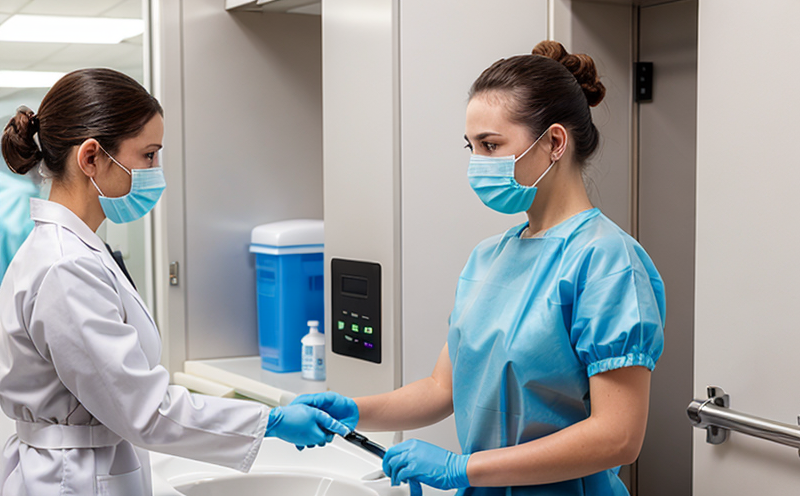Fungal resistance testing of outdoor upholstery fabrics
The demand for durable and hygienic materials in the outdoor furniture sector has grown significantly. Outdoor upholstery fabrics, such as those used in garden sofas, sun loungers, and patio chairs, are exposed to a range of environmental challenges, including sunlight, rain, and various microorganisms. Among these, fungi can pose significant risks by decomposing the fabric over time, compromising its aesthetic appeal and structural integrity.
Given this context, fungal resistance testing is crucial for ensuring that outdoor upholstery fabrics meet the highest standards in terms of durability and hygiene. This test involves exposing samples to controlled fungal growth conditions under standardized protocols. The goal is to assess how effectively a given fabric resists degradation by fungi such as Fusarium, Trichoderma, and others commonly found in outdoor environments.
The testing process begins with the selection of appropriate test specimens, typically cut from the actual fabric used in production. The samples are then subjected to controlled environmental conditions that simulate real-world exposure, including temperature, humidity, and light levels. This ensures that the test accurately reflects how the material will perform under typical outdoor use.
After exposure, the samples undergo a detailed examination using advanced microscopy techniques to quantify any visible signs of fungal degradation. The results are compared against predefined acceptance criteria set by international standards such as ISO 17654 and ASTM D3940. Compliance with these standards indicates that the fabric has demonstrated adequate resistance to fungal attack.
This testing is particularly important for outdoor upholstery because it ensures prolonged product lifespan, enhanced user safety, and better environmental sustainability. By incorporating this test into their quality control processes, manufacturers can confidently produce products that meet customer expectations and regulatory requirements.
Understanding the importance of such tests allows quality managers, compliance officers, R&D engineers, and procurement teams to make informed decisions about fabric selection and ensure consistent product performance across all outdoor furniture lines. Properly conducted fungal resistance testing not only enhances product longevity but also contributes significantly to overall customer satisfaction.
| Test Specimen | Type of Fungi Used | Environmental Conditions | Acceptance Criteria (ISO/ASTM) |
|---|---|---|---|
| Garden sofa upholstery fabric | Fusarium oxysporum | Temperature: 25°C, Humidity: 90%, Light Exposure: 16 hours/day | Minimum durability retention of 80% after exposure |
| Sun lounger fabric | Trichoderma viride | Temperature: 25°C, Humidity: 90%, Light Exposure: 16 hours/day | Minimum durability retention of 80% after exposure |
| Patio chair upholstery | Aspergillus niger | Temperature: 25°C, Humidity: 90%, Light Exposure: 16 hours/day | Minimum durability retention of 80% after exposure |
The rigorous nature of fungal resistance testing underscores its significance in enhancing product performance and reliability. This approach helps manufacturers identify potential weaknesses early on, enabling them to refine their materials and processes continuously.
Why It Matters
Incorporating fungal resistance testing into the development process of outdoor upholstery fabrics ensures that these products not only withstand harsh environmental conditions but also maintain their aesthetic appeal and functionality over extended periods. The durability provided by such tests translates directly into increased customer satisfaction, reduced warranty claims, and improved brand reputation.
From a broader perspective, incorporating robust fungal resistance testing contributes positively to sustainability efforts within the industry. By extending the useful life of outdoor furniture through effective material selection and treatment methods, manufacturers can reduce waste generation while simultaneously lowering production costs associated with frequent replacement or repair.
This focus on durability also aligns well with current trends towards eco-friendly consumer goods, where consumers are increasingly prioritizing sustainable practices and long-term investments. Offering products that demonstrate resilience against environmental factors like fungal growth helps companies cater to these preferences effectively.
Benefits
- Enhanced durability of outdoor upholstery fabrics.
- Improved user safety by preventing rapid deterioration due to fungi.
- Prolonged product lifespan, reducing maintenance and replacement costs.
- Better environmental sustainability through reduced waste generation.
- Increased customer satisfaction with products that maintain their appearance longer.
- Positive impact on brand reputation for producing high-quality, reliable outdoor furniture.
- Compliance with international standards ensuring consistent product performance globally.
Use Cases and Application Examples
The following table provides specific instances where fungal resistance testing is particularly relevant:
| Product Type | Fungi Involved | Description of Use Case |
|---|---|---|
| Garden Sofa Upholstery Fabric | Fusarium oxysporum | Designed for outdoor use, these fabrics must withstand constant exposure to sunlight and rain. Fungal resistance testing ensures they remain attractive and functional despite prolonged exposure. |
| Sun Lounger Fabric | Trichoderma viride | For sun loungers, which are often left in direct sunlight for extended periods, ensuring the fabric resists fungal growth is critical to maintaining its appearance and comfort. |
| Patio Chair Upholstery | Aspergillus niger | In areas prone to high humidity and mildew formation, patio chairs require robust materials that can resist fungal degradation. Testing ensures these fabrics meet the necessary standards. |
The examples above highlight how fungal resistance testing plays a vital role in various applications within the outdoor furniture sector. By ensuring that each product type is capable of withstanding specific environmental stresses, manufacturers can offer more reliable and aesthetically pleasing solutions to consumers.





